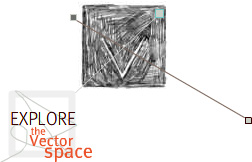The Virtual Window Interactive
Design by Erik Loyer
Designer's Statement
Anne Friedberg, Steve Anderson and I ran into an interesting quandary as the design of this project was underway. Once we had settled upon creating a kind of "playset" in which users could experiment with combining elements of a variety of window-mediated viewing experiences, our attention turned to exactly which elements the user would be able to combine. Instinctively, it seemed correct to separate content from dimension and dimension from form, so that it would be possible, for example, to take the image content from a silent film and slip it into a stained glass window, or to apply a Cinemascope aspect ratio to a portrait set in the frame of a digital TV.
The technique I came up with for handling the various visual presentations included a "frame" image that included the borders of the screen or window being shown, a mask that fixed the dimensions of the visual content to a particular shape and aspect ratio, and the visual content itself, whether still or moving. Of course, some of the formats we included, like cinema or painting, were quite forgiving of aspect ratio changes, as their rectangular borders could be easily stretched and sized while still remaining recognizable. Other formats, like the French window or mobile phone, would quickly reveal the digital artifice of the endeavor if stretched to fit uncommon dimensions.
We struggled for a while over how to address this issue, knowing that simply distorting our framing imagery to fit any possible aspect ratio would look silly, but not wanting to close off options for the user. After all, even combinations that might appear ridiculous could ultimately contribute to driving home the point of the piece's interactivity: to allow the user to enact the fluidity of the concept of "window" as it has manifested itself across eras.
In the case of the mobile phone, I tried to preserve those options for the user by designing a "generic mobile device" setting that would admit some degree of stretching and sizing, while still appearing to be hand-held. The idea was to simply put a giant silhouette of a hand behind the image content, thereby giving the proper sense of scale without attempting to render a particular device. The attempt failed miserably; the image didn't relate to the hand in any understandable way, and neither had anything to do with to any mobile device experience now extant.
Frustrated, I ended up scanning my hand holding my own cell phone and using that as the basis for the image. The result was much more compelling; the image captured the nuances of the contact between palm and device, the specificity of which immediately put to rest any thought of stretching the image to accommodate multiple aspect ratios. While such play would have boasted of the malleability of the digital, it would also have betrayed the grounding in physicality that is so critical to Anne's argument. Tracing the historical incarnations of the window from physical to digital is on the one hand an exercise in conceptual fluidity, but perhaps more important is the way in Anne's work celebrates the specific, painstaking design of visual experience as it has evolved over time.



